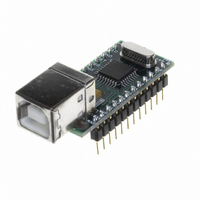DLP-USB245M-G DLP Design Inc, DLP-USB245M-G Datasheet - Page 2

DLP-USB245M-G
Manufacturer Part Number
DLP-USB245M-G
Description
MODULE USB-TO-TTL PARL FIFO CONV
Manufacturer
DLP Design Inc
Series
DLP-USB245Mr
Datasheet
1.DLP-USB245M-G.pdf
(15 pages)
Specifications of DLP-USB245M-G
Convert From (adapter End)
USB
Convert To (adapter End)
DB9 Female
Features
Integrated 6MHz-48MHz clock multiplier PLL
Interface Type
USB
Product
Interface Modules
For Use With/related Products
Windows® 98 or higher, Mac OS 8.5 or higher
Lead Free Status / RoHS Status
Lead free / RoHS Compliant
Lead Free Status / RoHS Status
Lead free / RoHS Compliant, Lead free / RoHS Compliant
Other names
813-1019
DLP-USB245M User Manual
GENERAL DESCRIPTION
The DLP-USB245M provides an easy cost-effective method
of transferring data to / from a peripheral and a host at up to
8 Million bits (1-Megabyte) per second. Its simple FIFO-like
design makes it easy to interface to any microcontroller or
microprocessor via IO ports.
To send data from the peripheral to the host computer
simply write the byte wide data into the module when TXE#
is low. If the (384 byte) transmit buffer fi lls up or is busy storing the previously written byte, the device takes TXE#
is low. If the (384 byte) transmit buffer fi lls up or is busy storing the previously written byte, the device takes TXE#
high in order to stop further data from being written until some of the FIFO data has been transferred over USB to the
host.
When the host sends data to the peripheral over USB, the device will take RXF# low to let the peripheral know that at
least one byte of data is available. The peripheral then reads the data until RXF# goes high indicating no more data is
available to read.
By using FTDI’s virtual COM Port drivers, the peripheral looks like a standard COM Port to the application software.
Commands to set the baud rate are ignored – the device always transfers data at its fastest rate regardless of the
application’s baud rate setting. The latest versions of the drivers are available for download from DLP Design’s
website at http://www.dlpdesign.com.
APPLICATION NOTES
USB devices transfer data in packets. If data is to be sent from the PC, a packet is built up by the application program
and is sent via the device driver to the USB scheduler. This scheduler puts a request onto the list of tasks for the USB
host controller to perform. This will typically take at least 1 millisecond to execute because it will not pick up the new
request until the next ‘ USB Frame’ (the frame period is 1 millisecond).
There is therefore a sizeable overhead (depending on your required throughput) associated with moving the data from
the application to the USB device. If data is sent ‘byte at a time’ by an application, this will severely limit the overall
throughput of the system as a whole.
It must be stressed that in order to achieve maximum throughput, application programs should send or receive data
using buffers and not individual characters.
Copyright © DLP Design 2002
Page 2 of 15
























